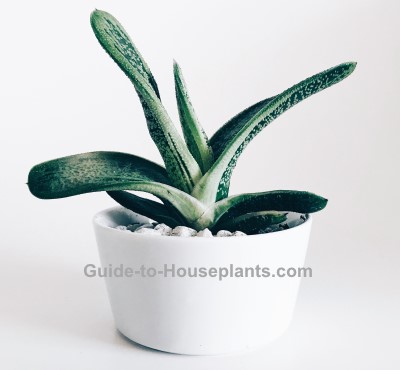Gasteria Plant
Gasteria is an unusual succulent often overlooked as a houseplant, but I think it's growing in popularity. It not only makes an eye-catching room accent, care for this plant is super-easy.
Set your plant in a semi-sunny location and leave it there. Its thick, succulent leaves retain water, so it rarely needs watering.

Get to Know Gasterias
Gasteria is a genus of more than 50 species of succulent, clump-forming perennials native to South Africa.
Leaves are thick, with rounded ends, and may have an upright growth habit, arching outward in a rosette, or fan shaped. Some varieties have a smooth surface and many have a pebbly texture. You can see from the picture here where it gets the common name, Ox Tongue.
Colors vary from dark green to lighter green, depending on the variety. Some are spotted with light shades of green or gray-green. Gasteria bicolor features thick, flat leaves with striped patterns.
How big do they get? Gasteria plants will reach a height up to 1 ft (30 cm) tall, and may spread about as wide.
Will they flower? Mature plants may send up flower spikes covered with small, bulbous blooms. Those flowers are stomach-shaped, rounded in the middle and tapered on one end. Its resemblance to a stomach is where this plant gets its genus name, Gasteria.
We are Family
Gasteria spp. are in the Lily family, along with Haworthias and Aloes. Most share a similar growth habit, growing into a stemless rosette of leaves.
Repotting Gasteria spp.
Gasteria plants are slow-growing, so you won't need to repot it often. However, mature plants will eventually grow offsets around the parent plant that can be cut away and potted separately, if you want.
Spring or early summer is the best time to repot.
It's a good idea to use a pot with drainage holes to allow excess water to drain freely. Terra cotta pots are ideal for succulents because they are porous, allowing moisture to evaporate through the sides of the container. Gasteria spp. have small roots, so a shallow container will do.
Problems and Solutions
Black spot is a fungus that may be caused by overwatering. You'll recognize it as large, black indentations surrounded by yellow halos. Fungus won't kill your plant, but you'll want to treat it with a fungicide specially made for black spot.
White fuzzy specks, called mealybugs sometimes attack succulent plants. It's a good idea to look over houseplants for pests once in a while. Treat any infestation immediately to prevent bugs from moving on to your other indoor plants.
Gasteria Plant Care
Light: Bright light, with some direct sun in winter.
Water: Drench and dry. Water thoroughly, then allow the potting medium to dry completely before watering again. Water the potting medium, not the plant. Avoid getting water on its leaves, which can cause fungus.
Humidity: Average room (around 40% relative humidity) suits this succulent.
Temperature: Average to warm room temperatures (65-85°F/18-29°C).
Soil: Cactus potting mix. Or add 1 part coarse sand with 2 parts all-purpose potting mix.
Fertilizer: Spring through fall, feed monthly with a 2-7-7 succulent plant fertilizer, diluted by half. Gasteria plants are slow-growing and won't need much plant food.
Propagation: Divide offsets in spring or early summer. Ease the plants out of the pot, then gently pull the offset plants away. Gasteria spp. have small roots, making them easy to separate. Pot them in barely moist sandy potting mix.


